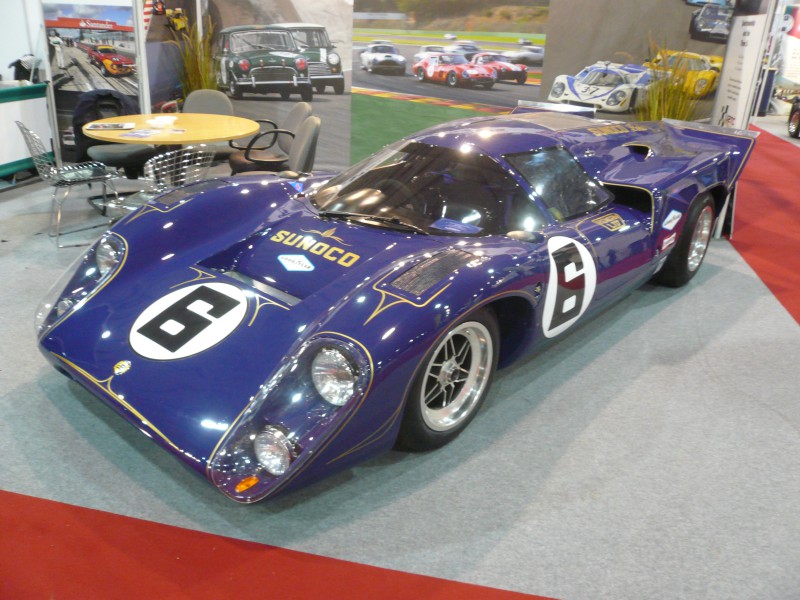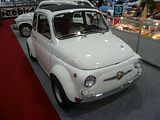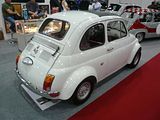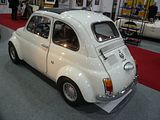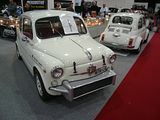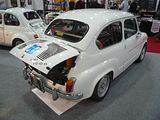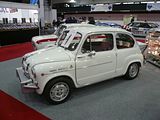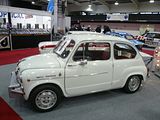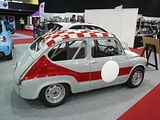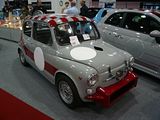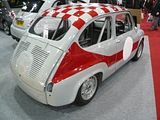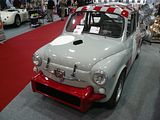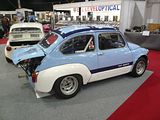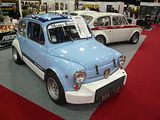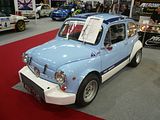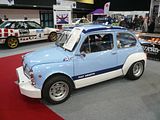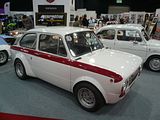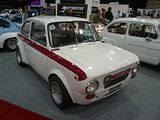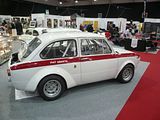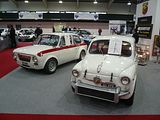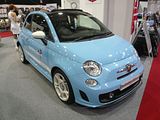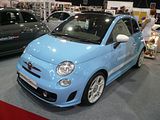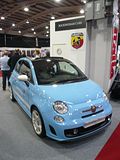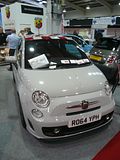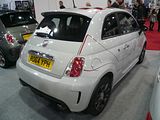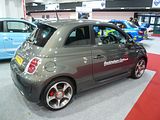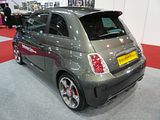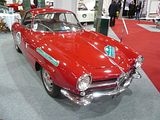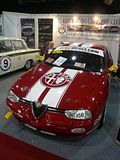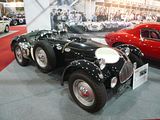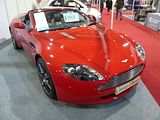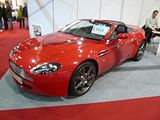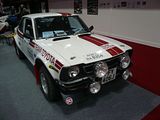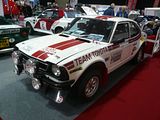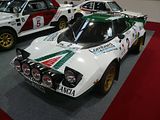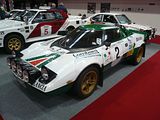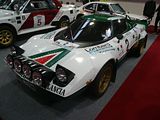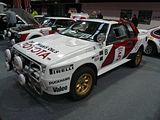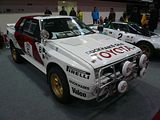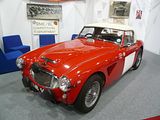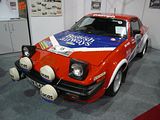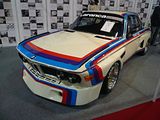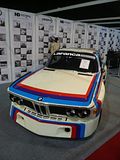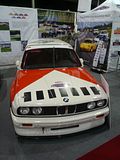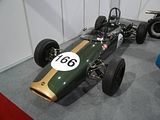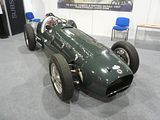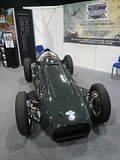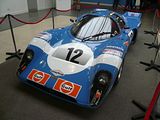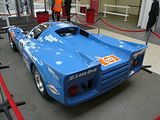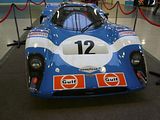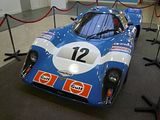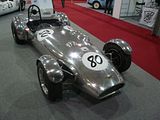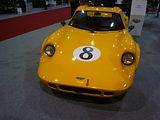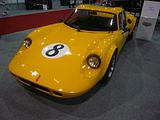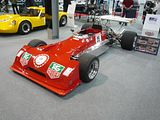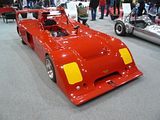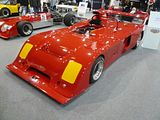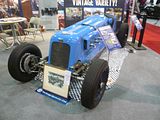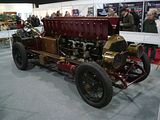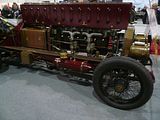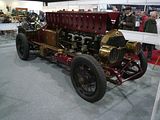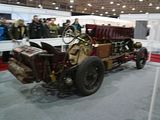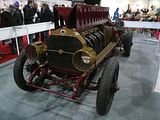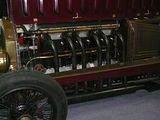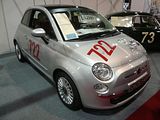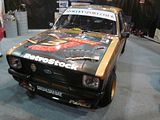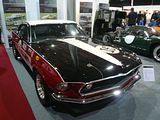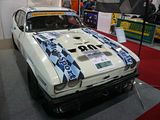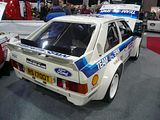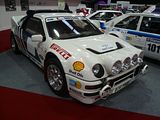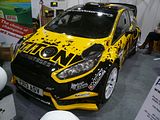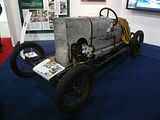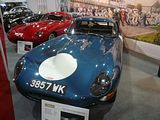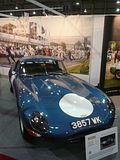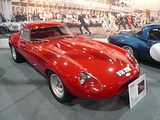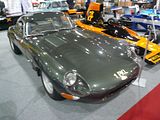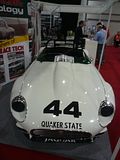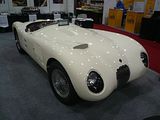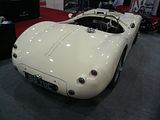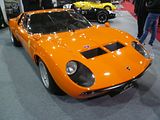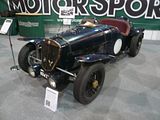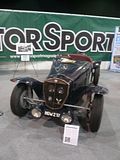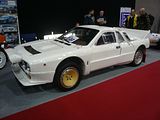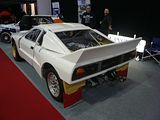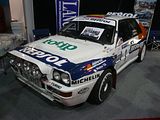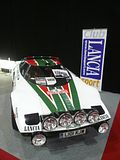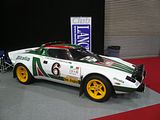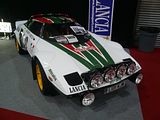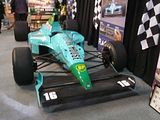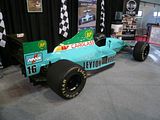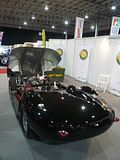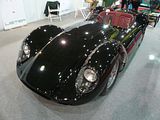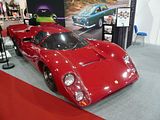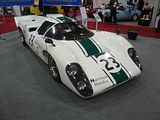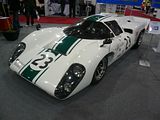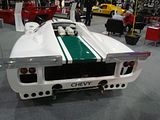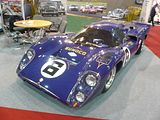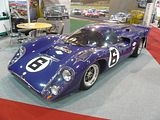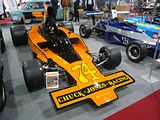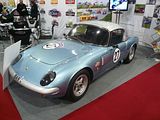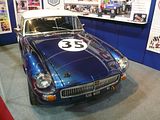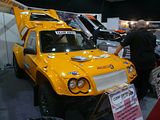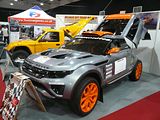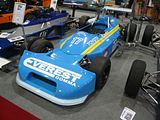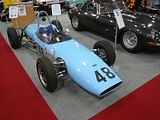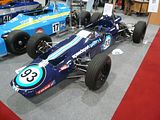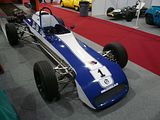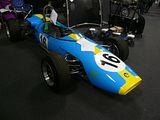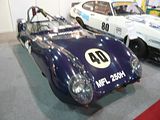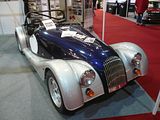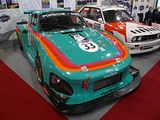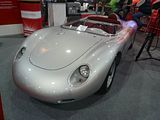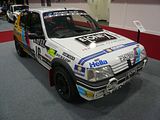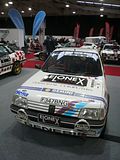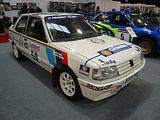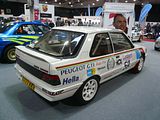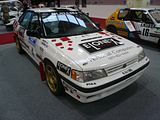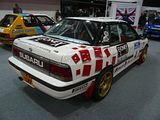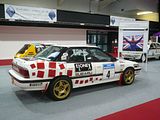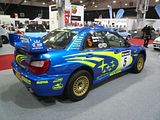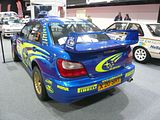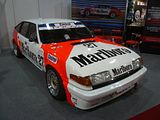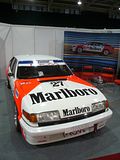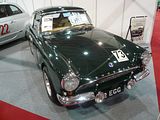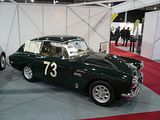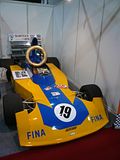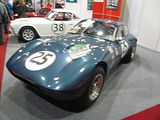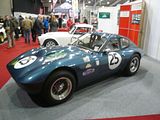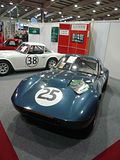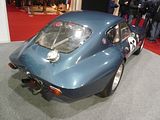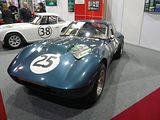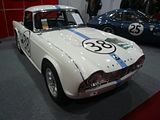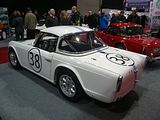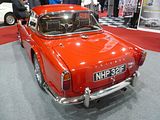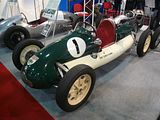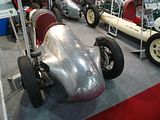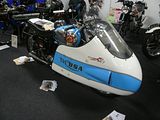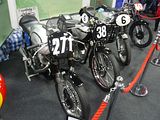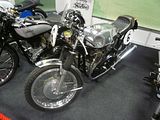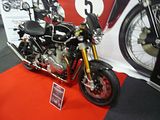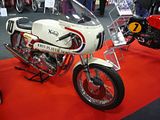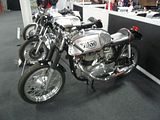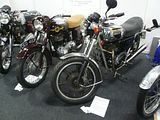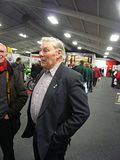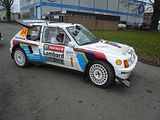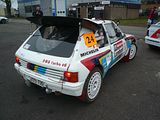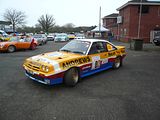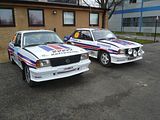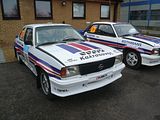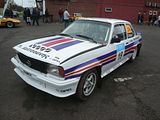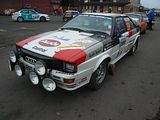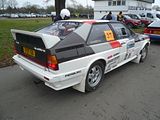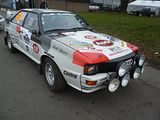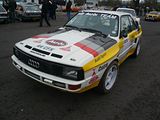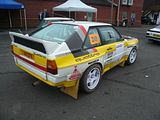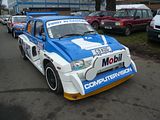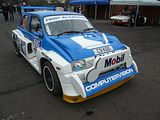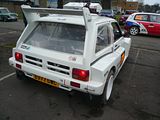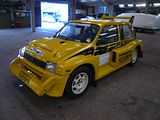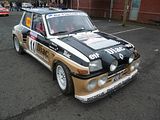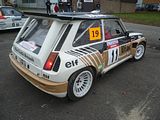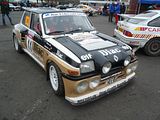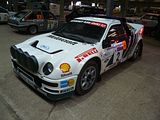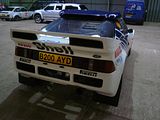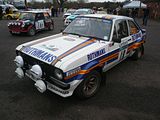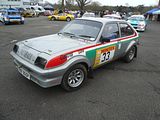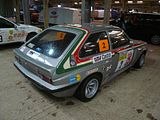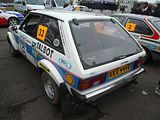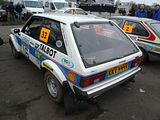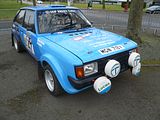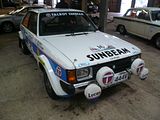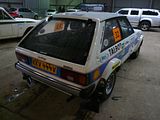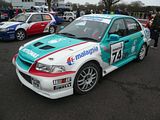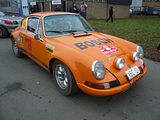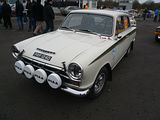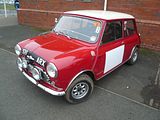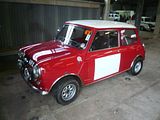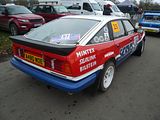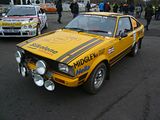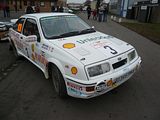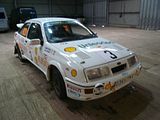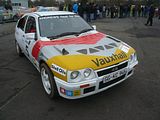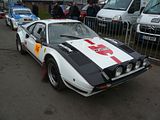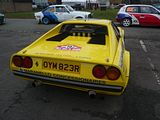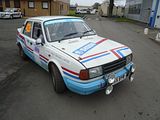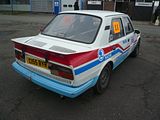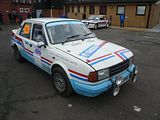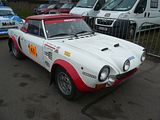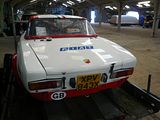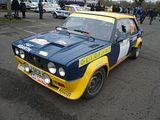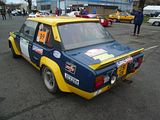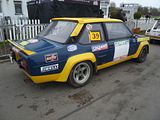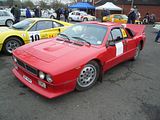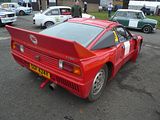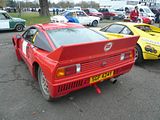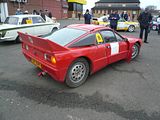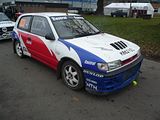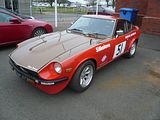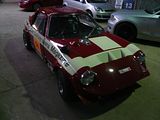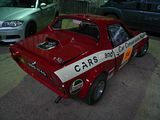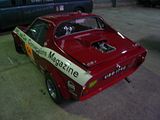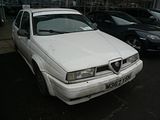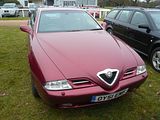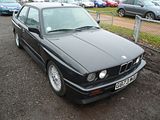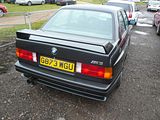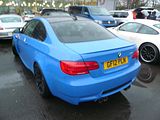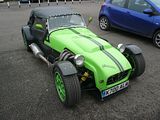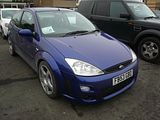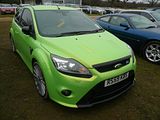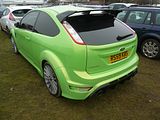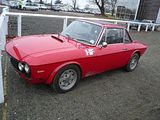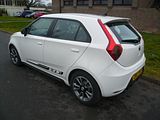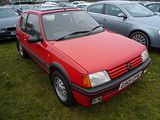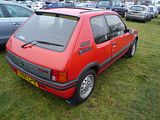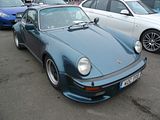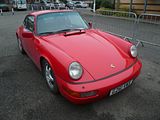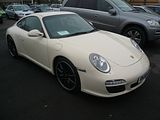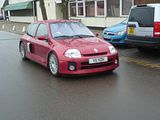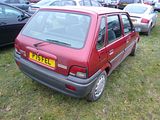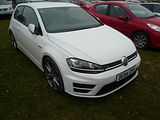Now an established and popular event in the calendar, Race Retro marks for me the first promise of spring and the start of “the season”. Held at Stoneleigh Park, Race Retro, a celebration of all forms of motor sport from bygone days (some longer gone than others!), combines a series of display stands spread over three exhibition halls with outdoor action including a carefully constructed rally “Special Stage” which is enjoyed by a seemingly ever growing number of enthusiastic owners of historic rally cars and a large crowd alike. The event has been running for 10 years, and I’ve attended every year since 2007, sometimes alone but mostly with a group of fellow TheMotor.net forummers. It’s always been an enjoyable, if rather chilly day out, and 2015 was to prove no exception, keeping us with plenty to look at and talk about from when the show opened until closing time. Here are the highlights:
DISPLAY CARS
ABARTH
A combined stand with cars supplied by marque specialist Middle Barton Garage, as well as new models from dealer Rockingham Cars of Corby, and Auto Italia magazine was a popular centrepiece in Hall 1. There were several classic Abarths, which – it will not surprise anyone who knows me – were among my favourite cars of the day. All dating from the 1960s, there were three different bodystyles shown based on the Fiat 500, 600 and 850 Coupe. In Abarth guises, that gave us the 500-based 695, the 850TC and 1000TC and Berline models and, based on the larger Fiat 850, the OT1600.
With the Abarth Punto now out of production and the new open-topped small sports car still eagerly awaited, Abarth’s range is currently all based on the 500. Three different models were displayed, with a mixture of closed and open topped cars on show.
ALFA ROMEO
There was hardly any evidence of Alfa this year, which is most unusual for this event. This glorious 1961 Giulietta SS was on a stand promoting self drive classic car tours, and there was a more recent 156.
ALLARD
Probably the best known, and certainly one of the best looking of Sydney Allard’s creations from the late 1940s and early 1950s was the J2.
ASTON MARTIN
This V8 Vantage was for sale at £44,500. A lot of money, perhaps, but it is a lovely car, still great to look at, and would be fun to drive.
BJORN WALDEGARD TRIBUTE
The first of a number of special displays was an area dedicated to the cars and career of rallying legend Bjorn Waldegard. Sadly Bjorn succumbed to cancer last year at the age of seventy years. A tall, modest and personable man, whose approachable manner belied his illustrious rallying history. Race Retro took the first opportunity to pay respect to Bjorn with a simple display of cars representing the Safari Toyota, his class winning RAC Toyota and the iconic 1975 RAC Lancia Stratos. None of those who saw it will ever forget Bjorn’s meteoric drive through the forest stages with missing rear bodywork, the rally was already lost on time penalties but he stormed through to take the moral victory with a huge majority of fastest special stage times. When the Drivers World Rally Championship was inaugurated in 1979, the first driver to lift that title was Sweden’s Bjorn Waldegard. Enjoying a rallying career that spanned four decades Bjorn took his first international rally victory at the wheel of a Porsche 911 in the 1969 Monte Carlo Rally, his last international victory came at the wheels of a Toyota on the 1990 Safari Rally, making Bjorn the oldest driver ever to win a WRC event.
BMC COMPETITIONS DEPARTMENT
Formed in 1955 and operating as the ‘works’ team of Britain’s largest motor manufacturer, British Motor Corporation, subsequently British Leyland, the ‘Competitions Department’ remained active at the top echelons of world rallying and endurance racing for twenty-five years until finally disbanded in 1981. This year is therefore the sixtieth anniversary of the formation of the team that brought rallying glory, famous victories and prestige with its red and white liveried Austin-Healeys, Austin A40s, and Mini Coopers of the 1960s and bowed out with the growling red white and blue TR7 V8s of the late 1970s. Accordingly, a special display was part of the event, though I have to say that I was expecting rather more than the trio of cars on a small stand which is all we got to see. That said, the Big Healey is the ex Pat Moss/Ann Wisdom car, and (undepicted), there was Paddy Hopkirk’s marathon winning works Mini Cooper, 6EMO, on the stand.
BMW
This was lovely 3.0 CSL “Batmobile”. Introduced in May 1972, the E9 3.0CSL was a homologation special built to make the car eligible for racing in the European Touring Car Championship. In this case, the “L” meant leicht (light), unlike other BMW designations, where it meant lang (long). The lightness was achieved by using thinner steel to build the unit body, deleting the trim and soundproofing, using aluminium alloy doors, bonnets, and boot lids, and using Perspex side windows. The five hundred 3.0CSLs exported to the United Kingdom were not quite as light as the others, as the importer had insisted on retaining the soundproofing, electric windows, and stock E9 bumpers on these cars. Initially using the same engine as the regular 3.0CS, the 3.0CSL was given a very small increase in displacement to 3,003 cc by increasing the engine bore by one quarter of a millimetre. This was done in August 1972 to allow the CSL to be raced in the “over three litre” racing category, allowing for some increase in displacement in the racing cars. In 1973, the engine in the 3.0CSL was given another, more substantial increase in displacement to 3,153 cc by increasing the stroke to 84 mm. This final version of the 3.0CSL was homologated in July 1973 along with an aerodynamic package including a large air dam, short fins running along the front bumpers, a spoiler above and behind the trailing edge of the roof, and a tall rear wing. The rear wings were not installed at the factory, but were left in the boot for installation after purchase. This was done because the wings were illegal for use on German roads. The full aero package earned the racing CSLs the nickname “Batmobile”. In 1973, Toine Hezemans won the European Touring Car Championship in a 3.0CSL and co-drove a 3.0CSL with Dieter Quester to a class victory at Le Mans. Hezemans and Quester had driven to second place at the 1973 German Touring Car Grand Prix at Nürburgring, being beaten only by Chris Amon and Hans-Joachim Stuck in another 3.0CSL. 3.0 CSLs went on to win the European Touring Car Championship again in every year from 1975 to 1979. The 3.0CSL was also raced in the IMSA GT Championship in 1975, with Sam Posey, Brian Redman, and Ronnie Peterson winning races during the season. Later, a larger engine was fitted, creating the 3.5CSL, which was built for Group 5 racing. BMW won three races in the 1976 World Championship for Makes with this model.
Fifteen years later, the E30 model 3 series was at the core of BMW’s motorsport activities, with the cars competing in Group A and various Touring Car series.
BRABHAM
Whilst this might look like a Repco Brabham BT 24 of the type Sir Jack Brabham used to win the World Championship in 1967, it is, in fact, a “continuation” replica. It certainly looks the part and as a proper continuation car it should be eligible for most F1 events – and at a fraction of the cost of the real thing.
BRM
It was great to see one of the legendary V16 BRM cars here. The V16 had a supercharged 1.5 litre V-16 cylinder racing engine built by British Racing Motors (BRM) for competing in Formula One. Designed in 1947 and raced until 1954–55, it produced 600 bhp at 12,000 rpm, although test figures from Rolls-Royce suggested that the engine would be able to be run at up to 14,000rpm. The engine was designed by a team consisting of Peter Berthon, Harry Mundy (who had designed engines for Jaguar), Eric Richter, and Frank May. It was conceived as basically two 750cc V8 engines back-to-back with cam drives and gears in the centre of the engine. Components were manufactured by various British companies, including English Steel – the crankshaft, Standard Motors – machining of the main engine components, sump, etc., and David Brown – the gears. Eventually there were around 350 companies that provided support to the project, including Rolls-Royce who designed and manufactured the two-stage centrifugal supercharger. Testing of the supercharger by Rolls-Royce involved the test specimen being mounted on the front of a Merlin supercharger. (RR personnel stated that that was just the kind of after-hours activity they enjoyed). Rolls-Royce also developed the flame traps for the inlet manifold, used to prevent a backfire causing an explosion in the highly compressed fuel/air mixture in the manifold. The flame trap was a feature not previously used on car engines, due to the relatively low amounts of supercharging then in use, but it was by then a necessity on high-powered piston aero engines such as the Merlin and Griffon. Twin-pot carburettors were designed for the engine by SU. The chassis of the BRM Type 15 car designed for the engine was made by Rubery Owen. The gearbox was designed by Mundy based on the one from the German pre-war 1939 1.5 litre V8 Mercedes-Benz W165 car, part of BRM’s ethos being to benefit from German technology that had so recently been used against Britain during World War II. Cameron Earl had visited Germany to retrieve any relevant documents. Rear suspension of the new BRM was also derived from Mercedes-Benz, and trailing arm front suspension from the Auto Unions. Girling provided special three-leading-shoe drum brakes for the car and the springing and shock absorbers were Lockheed air-struts incorporating silicon oil/air pocket adjustable springing/damping on all four wheels. The body panels and styling of the car were designed by Walter Belgrove of Standard Motors. Design of the car and all engineering drawings had been completed by the Spring of 1947. In many cases parts were produced in the form of donations to the BRM team by the respective companies, which had the advantage of reducing BRM’s spending. However, many parts were produced on a ‘when time is available’ basis by the suppliers and so were late in arriving, and because of the ‘gifted’ nature of the parts, BRM were unable to expedite delivery. Because of this, the engine itself was late, many completed components not arriving at BRM for assembly until as late as April 1948 to May 1949, reducing time available for testing before the start of the first season’s racing. The completed car/engine was first run on the aerodrome at RAF Folkingham in December 1949, driven by an unwell Raymond Mays, who was suffering from a high fever at the time. The use of Folkingham was the British Government’s sole contribution to the project. It had been intended to début the car at the 1950 Formula One Grand Prix race at Silverstone, the first race of the new Formula One World Championship, but problems with the engine, such as cylinders cracking, buckling of connecting rods, and piston failures, lead to the postponement of the race début. BRM instead had to settle for displaying the car at Silverstone with Mays driving several laps, after the BRM mechanics had worked all the previous night to get the car ready. The car was first entered in a race at the August 1950 Daily Express non-Championship race at Silverstone. The one car that the team had been able to prepare was flown from Folkingham into Silverstone on the morning of the race. It had missed the practice sessions but, after three proving laps driven by Frenchman Raymond Sommer, was allowed to start from the back of the grid. When the flag dropped at the start of the race, the BRM, carrying the racing number 8, merely lurched forward and then stopped, engine screaming, with Sommer unable to get any drive. The car was pushed over to the side of the track and withdrawn. One or both inboard universal joints had failed. This was perceived as a particularly unfortunate event for the car and British Racing Motors as the Daily Express newspaper had produced a glossy brochure about the new car, and the failure of the BRM at the race is considered to have somewhat coloured people’s perception of the car ever since. This was a prelude to the sort of difficulties that would continue to beset the car. as the engine initially proved a disappointment, possessing poor reliability so in the ensuing races, cars either Did Not Start or Failed To Finish races. Stirling Moss was sufficiently unimpressed that he wrote formally to Raymond Mays saying he would not drive it again. In the 1952 Formula One season, after BRM withdrew their V16 engined cars before a race in Turin whilst attempting to enlist Juan Manuel Fangio, leaving only Ferrari as the main contestants with no effective competition, the racing organisers abandoned the Formula One series, running the remaining year’s races as Formula Two. Slightly ironically, the car and engine went on to become quite reliable after the initial problems had been worked out., but by this time, the car had nowhere to race in the Formula it was intended for. In all, three Type 15s were built, and two Type 30s. This is one of the Type 30s.
CHEVRON
In recognition of the fact that 2015 marks its 50th anniversary, Chevron was chosen as the featured marque this year. Founded by Englishman Derek Bennett in 1965, the company struggled after his death in a hang gliding accident in 1978. Chevron were particularly renowned for their sports racing cars. On show in the entrance foyer was a Cosworth-engined B16 Chevron. Launched in 1969, it is reckoned to be the ‘Ultimate Chevron’, especially after winning its race debut with test driver Brian Redman at the wheel at the Nurburgring 500kms race in Sept 1969.. The B16 was a Group5/Group6 2-litre sports racer using tube frame construction. The show car was one of two built for famous Swiss racing driver, Jo Siffert. One featured the FWC 1760cc engine, and the other a BMW M10 unit.. When Solar Productions wanted cars to feature in the Steve McQueen classic film Le Mans, Siffert offered up his two car team. It was widely assumed that the BMW engine would be the more reliable one, and the camera gear was mounted on this one, only for the engine to blow up more or less immediately, so it is the Cosworth engined car – this very car – which starred in the film.
Inside Hall 3 was a stand which contained a number of other Chevron models as well as creations from designer Derek Bennett. Historically particularly significant was this Chevron B1 from 1965. Chassis #01, it has a pre-crossflow 1500cc Ford engine and it was driven by Derek Bernett and Brian Classick when new. This car was the founding car of the marque and has been owned by Vin Malkie since 1968. It was successful enough for seven further examples to be made. Chassis #01 is founding car of the marquee and has been owned by Vin Malkie since 1968.
Chevron went on to make numerous GTs and single seaters and developed an almost cult-like following for its cars, many of which were driven by well-known drivers starting off their careers. .A GT in fixed-head and open form, the B8 was homologated in 1968 as a Group 4 car. 44 examples were made, of which 35 used BMW engines. As well as this complete car, there was an example with the body off the chassis so visitors could see the mechanics of the car.
One of Chevron’s single seaters, the B25 was a monocoque design F2/F Atlantic single seater. John Lepp campaigned this 25 and was noted for competing in numerous Chevrons in the late 1960s and into the mid-1970s. This particular car still competes in hill climbs, driven by Keith Harris.
Chevron also brought along a 1974 B26, with a BDG 2000cc engine. This one has had many wins by Champion Racing Driver, BRDC member and owner John Burton.
The final Chevron shown was the B62, which was designed as a Group C2 sports car and was the only one made before the company closed. It’s latterly been campaigned by John Burton.
DELAGE
Respendent on the Shelsley Walsh Hill Climb stand, this Delage is a regular competitor at this venue and others of its ilk.
FIAT
One of the highlights of the show for me, and, judging by the crowds it attracted, many others, was this fabulous 1905 Fiat 200HP. Over 17 feet long and weighting nearly 2 tonnes, and sporting a vast Isotta Fraschini-designed 16.5 litre aero engine which occupies almost the entire length of the car, it looks suitably period, with a most wonderful patina. It was originally designed for an attempt on the World Land Speed Record 110 years ago, but Fiat never actually built it, so in fact it has only recently been completed, albeit using all original parts. I am promised that it will be at the forthcoming Brooklands Auto Italia event, where you will be able not only to see it, but to hear it and witness it in action on the track. A sight well worth it, as I can attest, having first come across the monster at last year’s Prescott VSCC meeting.
Billed as a one-off, this was a rather odd concept. A standard Fiat 500 had been given the Stirling Moss treatment, which meant his autograph featured in various places inside and outside the car and special Mercedes and 722 features were added, ranging from large stickers to the substitution of Fiat badges on the grille and wheel centres with Mercedes ones. Is it really worth the £12,999 asking price? Perhaps to someone, but it is definitely an odd-ball and will not be of interest to many people.
FORD
The Mark 2 Escort achieved notable success in motorsport when it was new, especially in the forests and on special stages as a rally car. Even now, it offers a cheap way into amateur motorsport, so it’s no surprise that many road cars have been converted and adapted for competition use, like this one.
Showing that it is not just Ford’s European cars that are up for motorsport was this American Mustang Boss 302 race car.
There were a number of sporting Fords from the 1980s here. First up was a Mark 3 Capri. These were popular in Group A when new, but this one has been modified more than somewhat and now has a V8 litre engine squeezed under the bonnet.
Two cars which never achieved their full potential, one through no real fault of its own were these: the ill-fated Escort RS1700T which never really achieved anything and the fabulous RS200, the car Ford designed as its Group B competitor and which was ready just as the series was axed. Whilst the RS200 is a car that you do see at events like this, I was not sure I’d ever seen an RS1700T. Some research after the event turned up that it is literally unique. Rallied briefly in South Africa before disappearing off the grid, the current owner found it in a barn in Germany, and is in the process of restoring it to exactly how Ari Vatanen tested it, even having period accurate tyres made up and buying the correct fire extinguishers!
Bringing things right up to date was this example of the latest Fiesta RS
GN
The GN Spider is a familiar sight at VSCC and other historic hill climb and racing events. On this occasion it graced the Shelsley Walsh stand.
JAGUAR
A number of the legendary E Type model were here, several in the style of the lightweight racing cars as well as one of the much later V12 cars which were raced in America
I also enjoyed this splendid C Type, even if it was a brand new recreation.
LAMBORGHINI
This bright orange Miura was quite a crowd puller, as these cars always are. Many will tell you that the Miura was the first true “supercar”, and whilst some might cites cars from the previous decade that could also be argued to fit the definition, it really did start something which continues to this day, with striking looks, explosive performance and a price tag that puts it out of reach of all but the very wealthiest. This was a 1969 S variant – and then some. Even harder and faster than standard in period, but now taken even further with a modern update on the period Jota spec – the hypercar of its era. It could be yours for £369,000.
LANCIA
Gracing the MotorSport stand was this, a very special car indeed. Belonging to the well known journalist Ronald “Steady” Barker who passed away earlier this month, at the grand old age of 95, this car started off as 1934 Lancia Astura. A large 7 seater seater, once owned by General Studd, and fitted with numerous ventilators and air ducts, one of which directed warm air onto the driver’s feet, Barker bought it cheaply as it was said to have a cracked piston. He proceeded to drive it for over 6000 miles before taking the engine apart and finding that indeed there was a cracked piston. With the car dismantled, he hit on the idea of making it a much smaller and more sporting car. That entailed reducing the 11 foot 10″ wheelbase to just 8 foot 1″, by cutting the chassis, then setting the rejoined rear section at an angle to take rear 1/2 elliptic springs. Otherwise the chassis was unaltered and he kept the same gearbox and axle ratios, but he converted the brakes to hydraulic action, using a wheel cylinders from a 1927 Chrysler Imperial, Lockheed actuation and a Clayton vacuum servo motor. Girling shock absorbers from a Morris Six went on the back, whilst he retained Lancia’s coil spring independent front suspension. A new all-enveloping body shell was made by AG Shaw of Sandgates. Although he cut t down a foot, the traditional Lancia grille was retained. Behind it was a radiator core adapted from a Morris van with a Ford header tank. The 17 degree narrow angle V6 3 litre engine was retained, though new pistons raised the compression ratio (still low at 6.0 to 1, as he intended to fit a supercharger at some later date. The Zenith carburation remained, but with bigger jets. Originally the engine put out 82 bhp at 4000 rpm, but Barker’s changes improved this to 95 – 100 bhp at 5000 rpm. With a significantly lower weight, the performance gains were significant. Barker turned up for his job interview at “The Autocar” (as it was known at them time), and it stayed with him until very recently. The car is part way through a restoration, which will be completed, but not until after it has taken part in his funeral, an event scheduled for the next couple of weeks. An amazing history, and seeing it at this event was a fitting tribute to the very well respected man who created it. RIP, “Steady”.
Elsewhere a trio of more recent Lancia were on show: a Delta Integrale, an 037 and a Stratos. None were quite what they might, at a quick glance, seem to be. The 037 on show was the most intriguing. The factory produced cars are incredibly rare and pricey on the rare occasions when they come up for sale. To address that, Rally Legend Replicas, who have already created kits to recreate Lancia’s fearsome S4, based on a Delta chassis, have done the same for the 037, following the same approach of staying true to the original wherever possible whilst providing a relatively affordable way to own this epic rally car. Starting with a reinforced and caged Montecarlo chassis, panels made from original moulds are used and the engine is a supercharged Beta Volumex 8-valve mounted longitudinally, as the original 16-valve is horrifically expensive.
LEYTON HOUSE
This 1990 Leyton House CG901 is chassis #003, the car which Ivan Capelli drove to a season best 2nd place finish in the 1990 French Grand Prix. The car was designed by Adrian Newey who then went on the following year to help design the 1992 World Championship winning FW14 model and more recently has been responsible for the Red Bull cars with which Sebastian Vettel has won four consecutive World Championships.
LISTER
Capitalising on the current vogue for very limited scale modern “continuation” series, it was announced last year that a small quantity of new Lister “Knobbly” Jaguars would be built. This is one of them.
LOLA
One of the prettier of the Sports/GT cars of the late 1960s was the Lola T70, and there were several of these on show. One was an original, as far as I could tell.
Shown on the Chevron stand was this, a modern “continuation” replica of the Lola T70 cars of the same name that were moderately successful in taking on the Ferraris and Porsche 917’s the late 60s and early 70s. They are built by the current incarnation of Chevron Racing Cars using original drawings and tools.
Badged EB, after the designer Eric Broadley, these cars are a modern follow-on recreation of the iconic Lola T70. Called the T76 continuation car, it is built to the same specification as the original T70 Mark 3b, and uses many original elements such as body moulds, jigs, factory drawings and patterns as well as some new parts left over from the 1967 production of the original. It complies with all the latest FIA Safety and Appendix K regulations which allows it to compete in most historic race car series around the world.
Dating from 1974 is this Formula 5000 T332 car driven by Chuck Jones.
LOTUS
Elan S2 racer
MG
MGB racer
MILNER
From a distance, I thought that these were probably Bowlers, but they turned out to be something different. Milner have specialised in parts to upgrade Japanese 4X4s for some years, but also offer a number of their own complete vehicles. The firm owes it origins to the days when founder Trevor Milner trialled a Series1 Land Rover. Developing an enthusiasm for the sport, he soon realised that building his own racers would not only be an ideal way to put his many ideas into action and have immense fun in the process. What would come in the following years would be a rapid evolution of racers and ideas to what we have today, the latest incarnation – the Milner R5. The first off road race car came in 1987. This was a full space frame beam axle car of which two were built and both survive and race to this day. These were followed in 1992 by the Milner R3. This went through various guises of independent suspension. It is still racing to this day.1998 Saw the Milner Pro-Truck on the drawing board. This car was our first attempt at a production run with all cars issued with a new registration, a full space frame and independent suspension. The Milner R4 differed as it had the silhouette of a Toyota Hi-Lux pickup truck. It has been campaigned successfully with wins in Comp Safaris, Hill Rallies and the British Off Road Championship. The R5 is an evolution of the earlier R4 vehicle. Like its predecessor, the Milner R5 Clubman is intended to bring independent space frame cars to an affordable level for the clubman competitor. With a purpose-designed glassfibre body that can be supplied to various levels of finish, it is up to the customer then to choose what else they want. The R5 can be supplied with whatever engine and transmission that the buyer specifies. Whilst Milner recommend the new 5.0 litre V8 Ford Coyote engine mated to their own six speed sequential dog, 6 speed H pattern or Milner paddle shift Milner transaxle and Milner differential, engine combinations used so far have included the BMW M3 3.2 Evo unit, Mitusbishi’s Lancer Evo9, Nissan V6, Rover V8, Lexus V8 and a Millington 2.7 Diamond engine. There are plenty of suspensions options as well. Milner will sell the vehicle in component form, or fully finished.
The LRM1, which looks like a modified Range Rover Evoque, was added to the range in 2013. It has a full space frame chassis with double wishbone, fully independent suspension, clad in a composite body shell scaled to 4/5 the size of a road going Evoque. The first production car benefits from the latest Land Rover 5.0 V8 supercharged engine producing in excess of 550 bhp and 680Nm of torque. The transmission is a 6 speed sequential gear box driving a Milner transfer box and Milner differentials with Quaife centres throughout. It is available as a kit or fully assembled. A tarmac version was announced in February 2015
MISC
MORGAN
Well known Morgan specialist Richard Thorne had a number of cars on their stand, all in racing guise.
PORSCHE
With so many recreations and reproductions around now, it is easy to assume when you see a rare car that it is not actually a genuine original. Spotting what looked like a 935, I assumed that this could be a case in point. It turned out that this Kremer Porsche 935 K3, was indeed the real deal. This particular 935 was brought back from Japan and subjected to a nut and bolt rebuild in 2010. It’s a 600hp flame-thrower of a car… Hitting 185mph in one of these must be little short of terrifying.
This RS61 replica was on the stand of a West Midlands company called Central Scanning, where they were showcasing their skills using scanners and 3D printing techniques to create new parts
RICHARD BURNS CARS
Marking 10 years since the very premature passing of British rallying legend Richard Burns, a special tribute display had 4 cars in which he had competed during his career, the rally-winning 205 and 309 GTIs along with the 1992 Group A Subaru Impreza as well as the 2001 World Rally Championship Impreza. The 309 was his first Peugeot works-supplied Group a rally car, and he used it to contest the 1991 RAC Rally, after a successful British Rally Championship year with a works-supported but privateer Peugeot Group N team. He finished 16th in the RAC that year, against stars such as Carlos Sainz, Ari Vatanen and Juha Kankunen, and notably, beating his future rival Colin McRae.
ROVER
After a disastrous return to motorsport with the XJC model in the mid 1970s, BL Group’s next attempt, with the Group A SD1 Rover Vitesse was far more successful, even though this was a larger and heavier car than many of its track competitors.
SUNBEAM
In the 1950s, Sunbeam had enjoyed a lot of success with the Talbot 90, Alpine and later the Rapier, but by the 1960s, they were looking for something new in which to compete. Coachbuilder Harrington created a fixed roof version of the Alpine sports car. which was more aerodynamic than the open topped roadster, and a few of these cars were sold for road use, but the venture was not particularly successful.
SURTEES
TS3 from 1974
TRIUMPH
A real rarity, this. My first thought that was that it was one of the Morgan SLR cars. It was not, but it turned out that my guess was not far off. Styled in much the same way, though all the details are subtly different, this is the one-off Triumph TR4 SLR. Produced at the same time as the three Morgan SLR cars, and in response to a change in the competition rules which encouraged the production of more aerodynamic bodies on sports racing cars, this has a TR4 chassis under the striking body. Like many such cars, it disappeared a long time ago, and was recently rediscovered and is now being restored to its former glory. Once complete, the new owner intends to take it on the track all round the world, so the chances are you could well see it again.
Alongside it was another rare and significant TR4. This is the only known survivor of the trio of cars that competed in the 1963 Sebring 500 race. Plucked from the ship as standard road cars, three were converted for racing. This one then underwent all sorts of changes, taking it along way from standard, and again was thought lost only to be discovered and is also now being restored to its original racing condition.
Third car on the stand was a regular road-going TR4A, impeccably presented.
500cc CARS
These little 500cc cars, with a mixture of engine and chassis providers, including Cooper, Kieft, Comet and Staride were popular when new in the immediate post war period as they were a relatively affordable way of having some fun in motorsport. They are still popular today.
BIKES
There’s always a significant collection of motor bikes on show at this event, too, with a selected marque and often a tribute to a famous bIker. This year, Norton was the chosen marque.
The tribute was to Mike Hailwood. Considered to be the ‘best motorcycle racer ever’ by experts the world over, Mike Hailwood is a legend to which others can only aspire to. He won his first World Championship at the age of twenty one. He won nine World Championships, 76 Grand Prix wins and fourteen T.T Races on the notoriously dangerous Isle of Man course. He was revered for his outstanding talent and versatility, he was a true sportsman, charismatic yet unassuming, he loved music and had a huge sense of fun. The Mike Hailwood Exhibit included Bikes, Trophies and Personal Memorabilia, Slideshows and Films on show, all hosted by David Hailwood, Mike’s son.
PERSONALITIES
One of the highlights of the event for me was the chance to talk directly to one of the guest stars. A number of personalities attend the event over the three days and there is a schedule for them to be interviewed for 15 minutes or so by Gemma Scott. When we got to this part of the event, David Brabham was just getting ready for his few minutes answering the questions, and then Barrie “Whizzo” Williams appeared as well, only to be told that he was “too late” for his planned slot and he would have to wait until David had finished. That meant that he did not stray far from the stage area and he ended up coming to the group of TheMotor.net attendees. I’ve no idea what David said, as we then had the next several minutes talking directly to “Whizzo”, I got the distinct impression that he would not run out of material, anecdotes and stories if you were with him for a whole evening. Encouraged by his father who himself had switched from racing bikes to cars after breaking rather a lot of bones in the TT, Barrie started his paid racing career in 1964 when he won the International Welsh Rally in a Mini Cooper. The name “Whizzo” came soon after when a report in AutoSport enquired as to who this Welsh “whizz-kid” was (he’s not Welsh, by the way, coming from Herefordshire). Drivers in Formula 3 in 1967 and 1968 followed. Since then he has driven all manner of different sorts of car, something which he relishes even now, as a very spritely septuagenarian. He said that it only usually takes a couple of laps to feel totally at home in whatever it is, be it Formula 3, touring car, GT car or whatever. Over a long and illustrious career, he counts himself as very privileged not just to have driven all manner of cars all round the world, but to have worked with and got to know most of the famous names in the sport. There was always a twinkle in his eye, and he clearly has a wicked sense of humour as well. A very special quarter of hour.
RALLY CARS
A big attraction for this event is the assembly of what seems to be an ever growing collection of historic rally cars. Some genuinely saw service in the day, whilst others are meticulous recreations. Simply Sideways, an enthusiasts group for those who own and want to drive such cars do a fantastic job every year in finding yet more cars to bring along. The organisers lay on a special stage and several times a day, the cars can be seen in action. Once again, this year, cars were dispatched at regular and frequent intervals so a good number of the 60 or so cars gathered could be seen in action at any one time, and if you were near enough to a loudspeaker, the unmistakeable voice of Tony Mason could be heard providing commentary. Further interest comes from the fact that this event always attract a former star or two. In the past this has included Jimmy McRae and the late Bjorn Waldegard. This year as well as Jmmy McRae, Dai Llewellyn and Bill Gwynne, it was another ace from the late 1970s and 1980s, Ari Vatanen who was on hand on both the Saturday and Sunday. As well as taking part in interviews on the live stage, he was reunited with two of his rally cars – the Rothmans Ford Escort and an Opel Manta 400 – where he was able to showcase his rally driving skills. Ari was one of the best-known rally drivers of the 1980’s, starring for Peugeot at the wheel of a 205 T16, and was on course to win the 1985 World Championship until a near-fatal accident in Argentina ended his season and nearly his life. The Finn recovered to return to the sport winning four Paris-Dakar Rallies in 1987, 1989, 90 and 91.
The Opel Manta took over from the related Ascona, which had enjoyed almost surprising success against slightly smaller rival rally cars in the late 1970s.
Of course, everything changed in 1980 with the advent of the Audi Quattro. The increased grip from the 4WD system, as well as explosive performance from the turbocharged 5 cylinder engine meant that Audi came to dominate the rally scene for the first half of the 1980s, changing the landscape for ever and also setting the stage for the road car manufacturer that is such a success now.
By the mid 1980s, anyone who was serious about rallying was hard at work developing ever more extreme cars, to comply with the Group B regulations, and this gave rise to some iconic machines. The formula was scrapped in 1985 following too many deaths of competitors, so some of these cars never really reached their potential. On show here was the MG Metro 6R4, the Renault R5 Turbo and the Ford RS200.
Prior to the arrival of the Quattro, three British cars had claimed the lion’s share of victories in the forests the Mark 2 Escort, the Chevette HSR and the Chrysler/Talbot Sunbeam Lotus and example of all three of these were on show in action. The Chevette that was present was an ex works car and the Sunbeam was driven by the late Henri Toivonen when new.
In the 1990s, it was the Japanese that dominated, with Subaru and Mitsubishi fielding cars that were capable of some improbable performances, with stars such as the late Colin McRae and Richard Burns at the wheel. The only example of this era was this early Lancer Evo.
Representing an earlier era was this Porsche 911 and a Lotus Cortina as well as examples of the legendary Mini Cooper
Other 1980s cars included an SD1 Rover 3500, a Toyota Corolla, the Sierra Cosworth and an Astra 4S
More unlikely cars were a couple of Ferrari 308s and a Lotus Esprit, though sadly., the latter seemed to live up to reputation and was not operational by Sunday morning.
Skoda enjoyed much success with their rear engined cars for many years. These machines had good traction and they claimed class wins in many events in which they were entered, including the RAC Rally year after year.
Three of my favourites were the Italian cars: an Abarth 124 Spider, and the two cars that succeeded it, the Abarth 131 and the fabulous Lancia 037. Magnigfico!
The Nissan Pulsar from the 1990s gave rise to the little known but supremely competent GTi-R road car version.
Another rarity was this Datsun 240Z “Super Samuri”. 77 such cars were converted from standard road cars by Spike Anderson at Samuri Conversions of Silverstone. Among the drivers at the time were Win Percy, who had apparently been at the show.
Perhaps the least recognisable of all the cars was this Cox GTM. It was rallied by Richard Hudson-Evans in the early 1970s and was sponsored by the long defunct “Cars and Cars Conversions” magazine.
No question, the loudest car of the group, and one of the most exciting to watch was this 5 litre V8 engined Firenza.
IN THE CAR PARK
It’s always having a quick look around the public carpark at an event like this, as many of the attendees not only own but bring along cars which are worth looking at The layout at Stoneleigh is such that some of the cars are along way away from the main event, but there was a VIP parking area right outside the exhibition halls, and those who had arrived early, as I had, got to park close by as well, so it was only these two areas which were visited. Unsurprisingly, there were quite a few interesting cars which I felt merited a picture and inclusion in this report.
ALFA ROMEO
A couple of now rare Alfas that I spotted were a rather grubby 155 and a more recent 166.
AUDI
This is one of a number of the current shape “B8” model RS4s that was present.
BMW
E30 model M3s are held in very high esteem these days, and prices for good ones (which is not all of the ones out there!) are accordingly high and climbing.
Will the E92 based M3 achieve the same cult desirability in 25 years time? Who knows. far more of them were made of course, but with the iconic 4 litre V8 consigned to history, the car just be one that people will look back longingly in years to come. It’s not that it is anything other than a highly desirable car now, of course!
CATERHAM
FORD
Among the Fast Fords parked up were RS versions of both the first and second generation Focus. Subtlety went out of the proverbial window for the second generation, a trend which the recently announced third generation car looks set to continue.
LANCIA
This Series 3 Fulvia Coupe is a reminder of the glory days of Lancia, when elegant styling was combined with exquisite engineering quality. How the mighty have fallen!
MG
I included this almost new MG3 simply because it is rare. Opinions vary on this car. Although it still feels quite cheap inside, those who have driven it say that it is not bad, and it is certainly a lot of car for the money. It would take a lot to convince the purists, and indeed me, that this is a “real” MG, though.
PEUGEOT
A lovely example of the legendary 205 GTi, a car whose appeal Peugeot have struggled (and so far failed) to recreate with successive generations of small hot hatches.
PORSCHE
There were a number of 911 models of very generation including a Kramer modified version of the G series car, and one of the latest 991 models in an unusual alabaster colour.
RENAULT
I caught this Clio V6 just as the owner appeared to be heading out of the event.
ROVER
Metro and Rover 100 cars are getting rare now, with far fewer survivors than the earlier Mini. This is one of the last, a Knightsbridge, very similar to the one my mother had until recently (hers was even the same Nightfire red colour, but a three door).
VOLKSWAGEN
One of the most praised cars of recent times, the Golf R combines discrete modifications to the standard Golf body with crushing competence.
Be in no doubt, this was a most enjoyable event, even after the weather turned on it, and forced the rally cars indoors during the afternoon. With the chance to catch up with other TheMotor.net forummers the night before over food and Caribbean cocktails in Leamington, it was a top weekend, and as an augury for the 2015 events season, a particularly auspicious start.

